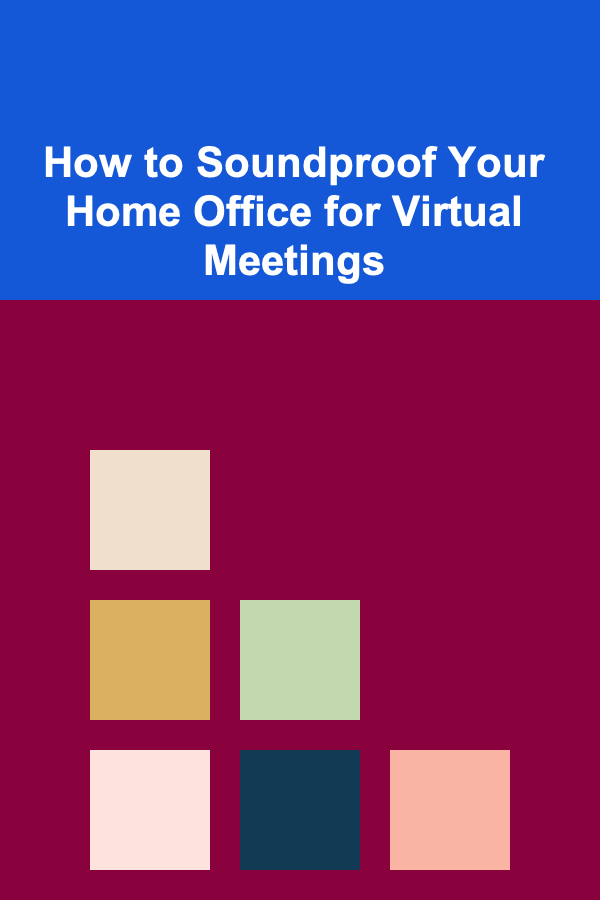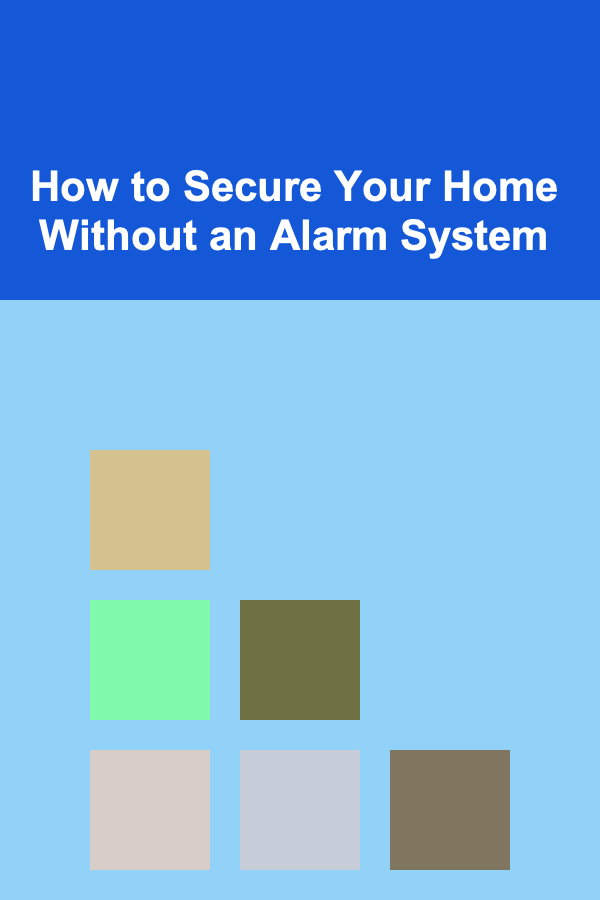
How to Soundproof Your Home Office for Virtual Meetings
ebook include PDF & Audio bundle (Micro Guide)
$12.99$9.99
Limited Time Offer! Order within the next:

With the rise of remote work, many professionals are setting up home offices to conduct virtual meetings, attend webinars, and engage in other professional activities. However, the home environment can sometimes be less than ideal for work, especially when it comes to noise. Whether it's the sound of traffic, noisy neighbors, household members, or random distractions, sound pollution can severely impact the quality of virtual meetings, making it harder to communicate and focus.
Soundproofing your home office is essential for ensuring a professional environment where you can focus on work without the distractions of unwanted noise. In this article, we'll explore the science of soundproofing and provide practical solutions for transforming your home office into a quiet, productive workspace for virtual meetings.
Understanding the Basics of Soundproofing
Before diving into the specifics of how to soundproof your home office, it's essential to understand the science behind soundproofing. Soundproofing is the process of reducing or blocking unwanted sound from entering or leaving a space. There are two primary types of noise:
- Airborne Noise: This is the most common type of noise, including sounds like voices, music, traffic, or machinery. Airborne noise travels through the air and can easily pass through thin walls, windows, and doors.
- Structure-Borne Noise: This type of noise results from physical vibrations that travel through the building structure. Common sources include footsteps, slamming doors, or appliances vibrating against the walls.
Effective soundproofing strategies aim to block, absorb, or isolate these types of noise. Understanding how sound travels is key to selecting the right methods and materials for soundproofing your home office.
How Sound Travels in Your Home
Sound travels through different mediums, including air, solid objects, and water. When you consider soundproofing, it's crucial to recognize how sound waves interact with the various components of your home office. Sound can enter your space through walls, windows, doors, floors, and ceilings, so to reduce unwanted noise, you need to target these areas specifically.
For example:
- Walls: Sound waves can travel through the thin surfaces of walls, especially if they're made of drywall. Even minor cracks, gaps, or spaces around outlets can allow sound to pass through.
- Windows: Glass is not particularly effective at blocking sound, and many windows in home offices are thin and single-glazed, which makes them a prime culprit for letting sound into your space.
- Doors: Hollow-core doors often fail to block sound, particularly if there's a gap at the bottom or around the edges. These gaps allow sound to travel easily from other rooms or hallways into your office.
- Floors and Ceilings: If your office is in an apartment or above a noisy space, sounds can travel through the floor or ceiling. Footsteps, talking, and vibrations from appliances can make their way into your office through these surfaces.
Understanding these pathways allows you to make informed decisions about which soundproofing techniques will work best for your office.
Seal Gaps and Cracks
One of the simplest and most cost-effective ways to soundproof your home office is to seal any gaps or cracks in walls, windows, doors, and even around electrical outlets. Airborne noise can easily pass through these small openings, making them prime areas to target for soundproofing.
Steps to Seal Gaps:
- Doors: Install weatherstripping around the edges of doors to create a tight seal. If you have a gap under the door, consider using a door sweep. These are inexpensive and highly effective in blocking noise.
- Windows: Use acoustic caulk or silicone sealant to fill any gaps around window frames. You can also add window inserts, which are a more advanced option that involves installing a secondary layer of glass to create an air gap.
- Walls: Cracks in the walls should be filled with acoustic caulk or standard caulk, depending on the size of the crack. You may also need to replace or re-seal older insulation in the walls if noise is particularly problematic.
- Electrical Outlets: Install outlet gaskets that can seal gaps around electrical outlets. This is a small, but effective measure that prevents sound from traveling through these often-overlooked spaces.
Sealing these gaps can significantly reduce the amount of noise entering your home office, creating a quieter space for virtual meetings.
Use Heavy Curtains or Soundproof Blinds
Another straightforward method to soundproof your home office is to use heavy curtains or soundproof blinds. While this won't completely block all noise, it can help reduce the volume of external sounds, particularly airborne noise like traffic or voices from outside.
Benefits of Soundproof Curtains:
- Noise Reduction: Heavy, dense fabrics such as velvet, polyester, or wool are great at absorbing sound waves, reducing the amount of noise entering the room.
- Thermal Insulation: Soundproof curtains can also help insulate your office against temperature changes, making your office more comfortable.
- Privacy: If you're concerned about privacy during virtual meetings, soundproof curtains provide an extra layer of protection from prying eyes, especially if you're in a busy area of the house.
When selecting soundproof curtains, look for ones that are specifically labeled as "acoustic" or "soundproof" and ensure that they are heavy enough to block out noise. Ideally, the curtains should cover the entire window and extend beyond the frame to prevent sound leakage from the edges.
If curtains aren't your preferred aesthetic, soundproof blinds made from materials like foam or vinyl are another option to consider. These offer similar benefits while maintaining a more minimalistic appearance.
Install Acoustic Panels
Acoustic panels are one of the most effective ways to manage sound in your home office. These panels absorb sound waves, which helps reduce noise and echoes in the room. Acoustic panels are made from porous materials that trap sound waves, preventing them from bouncing off hard surfaces like walls, ceilings, and floors.
Benefits of Acoustic Panels:
- Noise Absorption: Acoustic panels work by trapping sound within their material. This reduces the amount of sound that reflects off the walls and creates a quieter environment.
- Improved Audio Quality: For virtual meetings, acoustic panels can significantly improve the sound quality by reducing echoes and reverb, making your voice clearer to your meeting participants.
- Aesthetic Appeal: Acoustic panels come in various shapes, colors, and designs, allowing you to choose ones that complement the decor of your office. Some are even designed to look like artwork, offering both functional and aesthetic benefits.
When installing acoustic panels, focus on placing them on the walls that face noise sources (such as windows or adjacent rooms) and areas where sound tends to bounce. For optimal effectiveness, you can cover a larger surface area by placing panels across the entire wall, or at least around your desk area.
Use Area Rugs and Carpets
Soundproofing isn't just about reducing noise from walls and windows---flooring can also contribute significantly to noise levels in your office. If you have hardwood, tile, or laminate floors, sound can bounce off the surface, creating unwanted noise and echo.
Why Rugs and Carpets Help:
- Absorption of Footstep Noise: Rugs and carpets are excellent at absorbing impact noise, such as footsteps, which is especially useful if you're in a shared space with hard flooring.
- Echo Reduction: Rugs help reduce the amount of sound that bounces off hard floors, reducing overall echo and improving sound clarity in the room.
- Easy to Install: Simply adding a thick rug under your desk or in high-traffic areas can significantly reduce the noise level in your office without requiring any installation work.
When choosing a rug, opt for one that's thick and dense. Wool or cotton rugs tend to provide the best soundproofing effects. Additionally, a rug pad placed underneath the rug will enhance its ability to absorb sound and prevent it from sliding around.
Upgrade Your Doors and Windows
If noise is still an issue after sealing gaps and using curtains, consider upgrading your doors and windows. Many modern homes have doors and windows that aren't designed for soundproofing. However, there are solutions that can help enhance their noise-blocking capabilities.
Soundproofing Windows:
- Double-Glazed Windows: Replacing single-glazed windows with double-glazed windows can make a significant difference in blocking noise from outside. The extra layer of glass and the air gap between the panes help to reduce sound transmission.
- Window Inserts: If replacing windows isn't an option, consider adding window inserts. These are clear panels that fit into the existing window frame and add an additional layer of insulation against noise.
Soundproofing Doors:
- Solid Core Doors: If your office door is hollow, it might not be doing much to block sound. Replacing a hollow-core door with a solid-core one can help reduce noise transmission significantly.
- Door Sweeps and Weatherstripping: Ensure your door is tightly sealed by adding a door sweep at the bottom and weatherstripping around the edges. This will prevent sound from leaking through gaps.
Upgrading your doors and windows can be an investment, but it can offer significant noise reduction and create a much quieter home office.
Create a Quiet Zone with a Room Divider
If your home office is located in a larger, more open space, using a room divider can help create a designated quiet zone. A room divider can help isolate your workspace from noise in other parts of the house, ensuring that you have a focused environment for virtual meetings.
Options for Room Dividers:
- Acoustic Panels: As mentioned earlier, acoustic panels can be used as room dividers. These will not only block sound but also improve the acoustics within your workspace.
- Heavy Curtains: You can also use heavy curtains or soundproof drapes to create a barrier between your office area and the rest of the room.
- Bookshelves or Furniture: Tall bookshelves, cabinets, or large furniture pieces can act as effective sound barriers, absorbing and blocking noise from adjacent spaces.
A room divider is a simple and effective way to create a quiet and soundproof zone within an open-plan space, allowing you to focus on virtual meetings without distractions.
Utilize White Noise or Sound Masking
In some cases, completely blocking out all noise might not be possible, especially if you're in a particularly noisy environment. In such cases, white noise machines or sound masking apps can help you mask unwanted sounds.
Benefits of White Noise:
- Masking External Noise: White noise generates a consistent, soothing sound that can mask sudden, jarring noises, such as car alarms, conversations, or construction work.
- Improved Focus: Many people find that white noise helps them concentrate better during virtual meetings by blocking out distractions.
- Better Sleep: White noise is also commonly used to improve sleep, but it can help you focus during work hours as well.
White noise machines are small and affordable and can be placed on your desk or near your office entrance. Additionally, there are smartphone apps that provide white noise or nature sounds if you prefer a more portable solution.
Conclusion
Soundproofing your home office for virtual meetings is essential for ensuring that you have a professional and distraction-free workspace. By combining several techniques---such as sealing gaps, using acoustic panels, installing heavy curtains, and adding rugs---you can significantly reduce noise and improve the acoustics in your office. These steps will not only make your meetings more productive but will also help you create a more comfortable and focused work environment. Whether you're dealing with external noise or noise from other parts of the house, the right soundproofing strategies will allow you to conduct virtual meetings with clarity and professionalism.
Reading More From Our Other Websites
- [Home Party Planning 101] How to Plan a Decade-Themed Party: A Comprehensive Guide
- [Organization Tip 101] The Cost of Blown-In Attic Insulation: Is It Worth the Investment?
- [Personal Investment 101] How to Leverage The Best Investment Apps to Diversify Your Portfolio Beyond Stocks and Bonds
- [Organization Tip 101] How to Set Up a Communication System for Volunteers
- [Organization Tip 101] How to Streamline Your Sewing Process with Organized Tools
- [Home Budget 101] How to Save Money on Home Security Without Sacrificing Safety
- [Horseback Riding Tip 101] Best Horseback Riding for Seniors: Gentle Rides and Accessible Equestrian Experiences
- [Home Pet Care 101] How to Establish a Routine for Pet Care
- [Home Budget Decorating 101] How to Style Your Home with Low-Cost Textiles and Fabrics
- [Personal Financial Planning 101] How to Maximize Your Savings with High-Interest Accounts

How to Do a DIY Home Renovation Like a Pro
Read More
How to Invest in Index Funds for Long-Term Growth
Read More
How to Secure Your Home Without an Alarm System
Read More
How to Use Clear Storage Bins for Easy Organization
Read More
How to Write a Book to Promote Your Business
Read More
What Are the Benefits of Organizing Your Cleaning Routines?
Read MoreOther Products

How to Do a DIY Home Renovation Like a Pro
Read More
How to Invest in Index Funds for Long-Term Growth
Read More
How to Secure Your Home Without an Alarm System
Read More
How to Use Clear Storage Bins for Easy Organization
Read More
How to Write a Book to Promote Your Business
Read More